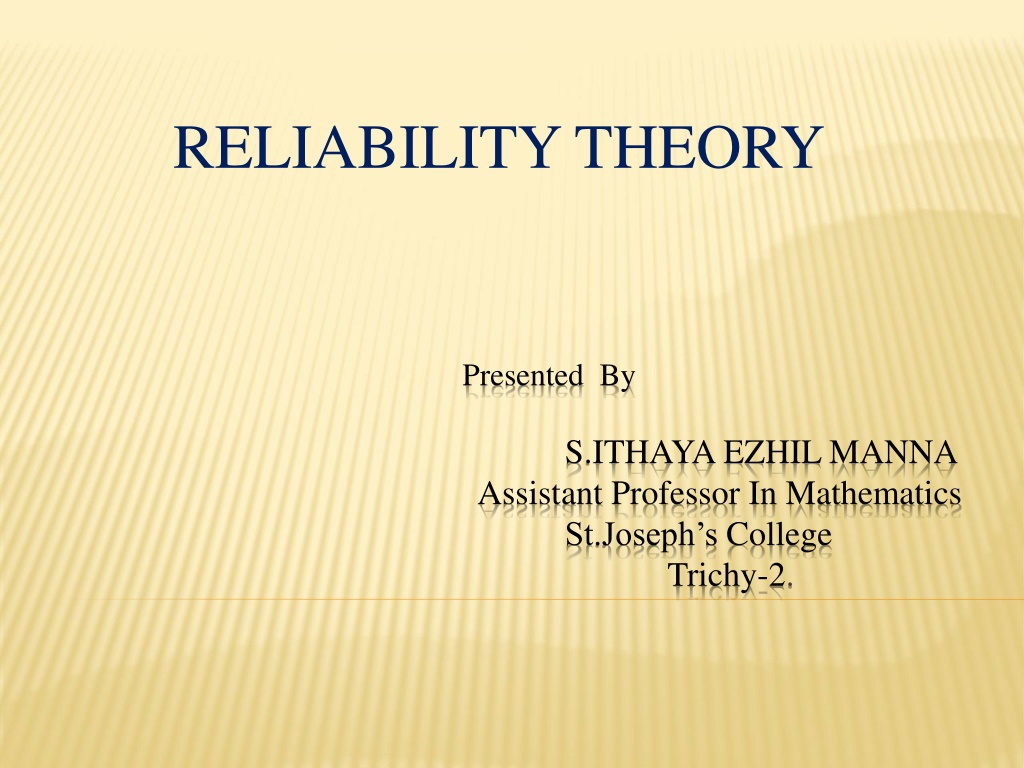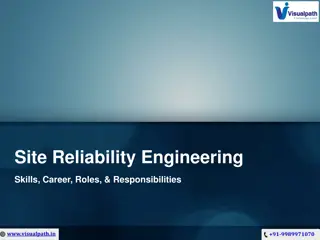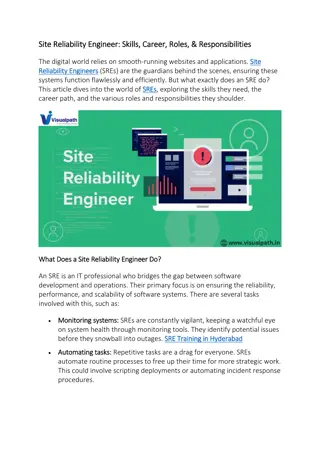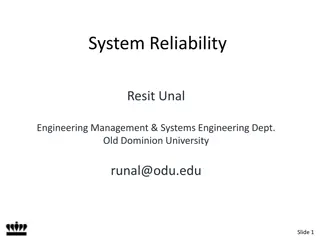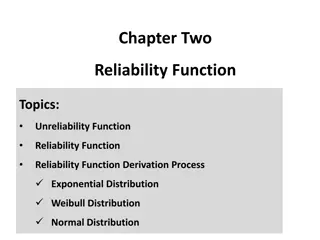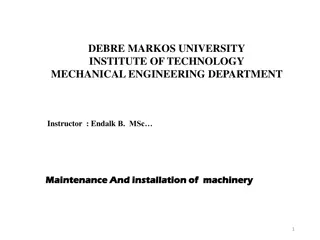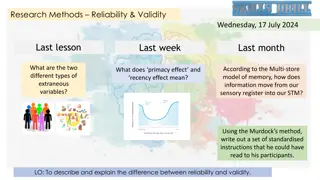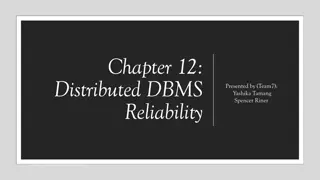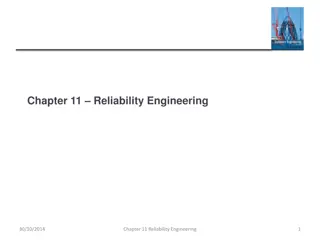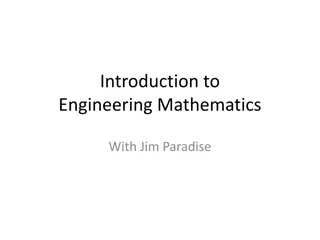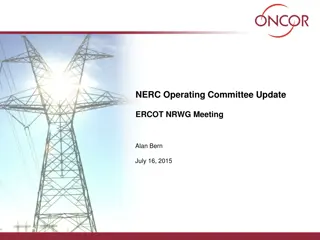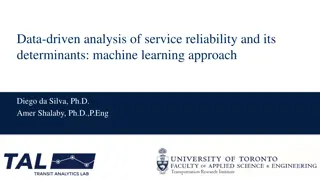Understanding Reliability Theory in Engineering and Mathematics
Reliability theory, presented by S. Ithaya Ezhil Manna, explains the concept of reliability as the probability of a component functioning properly over time. The theory defines reliability in terms of the random variable X representing component life or time to failure. Key points include the definition of reliability function R(t), failure rate or hazard rate, and the assumptions related to component reliability.
Uploaded on Oct 05, 2024 | 0 Views
Download Presentation

Please find below an Image/Link to download the presentation.
The content on the website is provided AS IS for your information and personal use only. It may not be sold, licensed, or shared on other websites without obtaining consent from the author. Download presentation by click this link. If you encounter any issues during the download, it is possible that the publisher has removed the file from their server.
E N D
Presentation Transcript
RELIABILITY THEORY Presented By S.ITHAYA EZHIL MANNA Assistant Professor In Mathematics St.Joseph s College Trichy-2.
Let the random variable X be the life time or the time to failure of the component. The reliability of the component is defined by R(t) = P(X> t).
Let the random variable X be the life time or the time to failure of the component. The reliability of the component is defined by R(t) = P(X> t). Remarks: 1. The component is assumed to be working properly at time t = 0 (i.e) R(0) = 1.
Let the random variable X be the life time or the time to failure of the component. The reliability of the component is defined by R(t) = P(X> t). Remarks: 1.The component is assumed to be working properly at time t = 0 (i.e)R(0) = 1. 2.No component can work forever without failure limn R(t) = 0.
Let the random variable X be the life time or the time to failure of the component. The reliability of the component is defined by R(t) = P(X> t). Remarks: 1.The component is assumed to be working properly at time t = 0 (i.e)R(0) = 1. 2.No component can work forever without failure limn R(t) = 0 3.R(t) is a monotone non-increasing function of t.
Let the random variable X be the life time or the time to failure of the component. The reliability of the component is defined by R(t) = P(X> t). Remarks: 1.The component is assumed to be working properly at time t = 0 (i.e)R(0) = 1. 2.No component can work forever without failure limn R(t) = 0 3.R(t) is a monotone non-increasing function of t. 4. For t < 0, reliability has no meaning, but we let R(t) = 0, for t < 0.
FAILURE RATE OR HAZARD RATE: The failure rate h(t) at time t is defined to be ( ) f t Density Function = = ( ) h t ( ) R t Survival Function
FAILURE RATE OR HAZARD RATE: The failure rate h(t) at time t is defined to be ( ) f t Density Function = = ( ) h t ( ) R t Survival Function t ( ) h x dx 0 = ( ) . R t e
FAILURE RATE OR HAZARD RATE: The failure rate h(t) at time t is defined to be Density t R ) ( ( ) f t Function = = ( ) h t Survival Function t ( ) h x dx 0 = ( ) . R t e Cumulative Failure Rate: t = ( ) ( ) . H t h x dx 0
FAILURE RATE OR HAZARD RATE: The failure rate h(t) at time t is defined to be Density t R ) ( ( ) f t Function = = ( ) h t Survival Function t ( ) h x dx 0 = ( ) . R t e Cumulative Failure Rate: t (t ) H = = ( ) ( ) . ( ) . H t h x dx R t e 0
PARAMETERS OF RELIABILITY 1.MTTF: Mean Time To Failure = ( ) . MTTF R t dt 0
PARAMETERS OF RELIABILITY 1.MTTF: Mean Time To Failure = ( ) . MTTF R t dt 0 2.MTBF: Mean Time Between Failures 1 FR FR + + = , where FR is the failure MTBF + ... FR 1 2 n rate of component each of system the up to ' components n' .
PARAMETERS OF RELIABILITY 1.MTTF: Mean Time To Failure = ( ) . MTTF R t dt 0 2.MTBF: Mean Time Between Failures 1 FR FR + + = , where FR is the failure MTBF + ... FR 1 2 n rate of component each of system the up to ' components n' . 3.MTTR: Mean Time To Repair MTBF MTTR = . MTTF
EXPONENTIAL DISTRIBUTION Suppose the random variable X (be the lifetime of a component) is said to follow the exponential distribution,then
EXPONENTIAL DISTRIBUTION Suppose the random variable X (be the lifetime of a component) is said to follow the exponential distribution,then 0 , . . ) ( = = e f d p T f T . 0 T and T T = = = = ( ) . . ( ) ( ) 1 . F T c d f P X T f T dT e 0 T = = = = ( ) ( > T ) 1 T ( ) 1 ( ) . R T P X P X T F T e ( ) f T e = = = ( ) . h T T ( ) R T e
EXPONENTIAL DISTRIBUTION Suppose the random variable X (be the lifetime of a component) is said to follow the exponential distribution,then 0 , . . ) ( = = e f d p T f T . 0 T and T T = = = = ( ) . . ( ) ( ) 1 . F T c d f P X T f T dT e 0 T = = = = ( ) ( > T ) 1 T ( ) 1 ( ) . R T P X P X T F T e ( ) f T e = = = ( ) . h T T ( ) R T e Hence,the exponential lifetime distribution is a constant failure rate [ It s the only distribution with a constant failure rate].
WEIBULL DISTRIBUTION: The density function is given by, t t 1 = ( ) for , all t 0, 0 > and > 0. f t e t t 1 = = = = ( ) . . ( ) ( ) 1 . F t c d f P X t f t dt e 0 t 1 = = = = ( ) ( > ) t 1 ( ) 1 ( ) . R t P X P X t F t e t 1 t 1 ( ) f t e t = = = ( ) . h t t 1 ( ) R t e
Failure rate of the weibull distribution with various values of and = 1 1 . If <1,the function is DFR. 2. If = 1,the function is CFR. 3. If >1,the function is IFR.
APPLICATIONS 1. Reliability engineering - Reliability engineering that emphasizes dependability in the lifecycle management of a product. Dependability, or reliability reliability, describes the ability of a system component to function under stated conditions for a specified period of time. 2. 2. System Reliability System Reliability - - The probability that a system including all hardware, firmware, and software, will satisfactorily perform the task for which it was designed or intended, for a specified time and in a specified environment. 3. Structural reliability. Reliability engineering is system or system,
REFERENCES: 1 . J.Medhi,Stochastic Processes,New Age International Publishers,Second Edition,New Delhi,1994. 2 . U.Narayan Bhat,Elements of Applied stochastic Processes,second Edition,John Wiley & Sons,New York,1972. 3 . N.V.Prabhu,stochastic processes,Macmillan,NewYork,1970.
